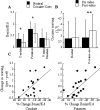Cocaine cues and dopamine in dorsal striatum: mechanism of craving in cocaine addiction
- PMID: 16775146
- PMCID: PMC6674019
- DOI: 10.1523/JNEUROSCI.1544-06.2006
Cocaine cues and dopamine in dorsal striatum: mechanism of craving in cocaine addiction
Erratum in
- J Neurosci. 2006 Jul 5;26(27):table of contents
Abstract
The ability of drugs of abuse to increase dopamine in nucleus accumbens underlies their reinforcing effects. However, preclinical studies have shown that with repeated drug exposure neutral stimuli paired with the drug (conditioned stimuli) start to increase dopamine by themselves, which is an effect that could underlie drug-seeking behavior. Here we test whether dopamine increases occur to conditioned stimuli in human subjects addicted to cocaine and whether this is associated with drug craving. We tested eighteen cocaine-addicted subjects using positron emission tomography and [11C]raclopride (dopamine D2 receptor radioligand sensitive to competition with endogenous dopamine). We measured changes in dopamine by comparing the specific binding of [11C]raclopride when subjects watched a neutral video (nature scenes) versus when they watched a cocaine-cue video (scenes of subjects smoking cocaine). The specific binding of [11C]raclopride in dorsal (caudate and putamen) but not in ventral striatum (in which nucleus accumbens is located) was significantly reduced in the cocaine-cue condition and the magnitude of this reduction correlated with self-reports of craving. Moreover, subjects with the highest scores on measures of withdrawal symptoms and of addiction severity that have been shown to predict treatment outcomes, had the largest dopamine changes in dorsal striatum. This provides evidence that dopamine in the dorsal striatum (region implicated in habit learning and in action initiation) is involved with craving and is a fundamental component of addiction. Because craving is a key contributor to relapse, strategies aimed at inhibiting dopamine increases from conditioned responses are likely to be therapeutically beneficial in cocaine addiction.
Figures


References
-
- Breier A, Su TP, Saunders R, Carson RE, Kolachana BS, de Bartolomeis A, Weinberger DR, Weisenfeld N, Malhotra AK, Eckelman WC, Pickar D (1997). Schizophrenia is associated with elevated amphetamine-induced synaptic dopamine concentrations: evidence from a novel positron emission tomography method. Proc Natl Acad Sci USA 94:2569–2574. - PMC - PubMed
-
- Breiter HC, Gollub RL, Weisskoff RM, Kennedy DN, Makris N, Berke JD, Goodman JM, Kantor HL, Gastfriend DR, Riorden JP, Mathew RT, Rosen BR, Hyman SE (1997). Acute effects of cocaine on human brain activity and emotion. Neuron 19:591–611. - PubMed
-
- Brown EE, Fibiger HC (1992). Cocaine-induced conditioned locomotion: absence of associated increases in dopamine release. Neuroscience 48:621–629. - PubMed
Publication types
MeSH terms
Substances
Grants and funding
LinkOut - more resources
Full Text Sources
Other Literature Sources
Medical
